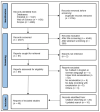Use of Lower Limb Exoskeletons as an Assessment Tool for Human Motor Performance: A Systematic Review
- PMID: 36991743
- PMCID: PMC10057915
- DOI: 10.3390/s23063032
Use of Lower Limb Exoskeletons as an Assessment Tool for Human Motor Performance: A Systematic Review
Abstract
Exoskeletons are a promising tool to support individuals with a decreased level of motor performance. Due to their built-in sensors, exoskeletons offer the possibility of continuously recording and assessing user data, for example, related to motor performance. The aim of this article is to provide an overview of studies that rely on using exoskeletons to measure motor performance. Therefore, we conducted a systematic literature review, following the PRISMA Statement guidelines. A total of 49 studies using lower limb exoskeletons for the assessment of human motor performance were included. Of these, 19 studies were validity studies, and six were reliability studies. We found 33 different exoskeletons; seven can be considered stationary, and 26 were mobile exoskeletons. The majority of the studies measured parameters such as range of motion, muscle strength, gait parameters, spasticity, and proprioception. We conclude that exoskeletons can be used to measure a wide range of motor performance parameters through built-in sensors, and seem to be more objective and specific than manual test procedures. However, since these parameters are usually estimated from built-in sensor data, the quality and specificity of an exoskeleton to assess certain motor performance parameters must be examined before an exoskeleton can be used, for example, in a research or clinical setting.
Keywords: diagnosis; gait; proprioception; range of motion; stiffness; strength; test; wearable devices; wearable robotics.
Conflict of interest statement
The authors declare that the research was conducted in the absence of any commercial or financial relationships that could be construed as a potential conflict of interest.
Figures




References
Publication types
MeSH terms
Grants and funding
LinkOut - more resources
Full Text Sources
Medical

